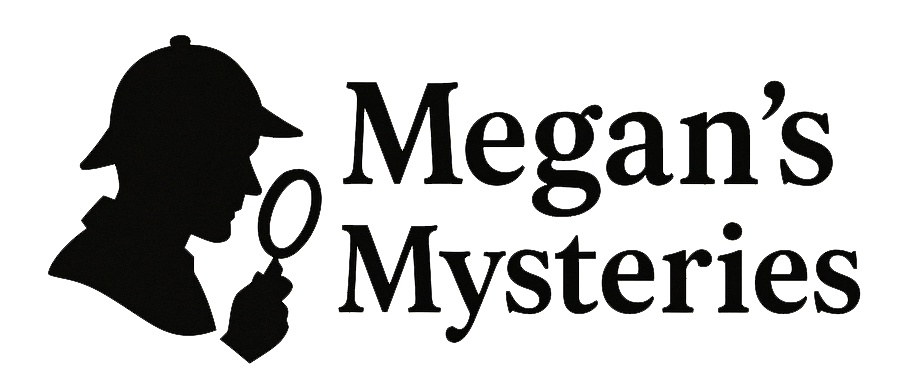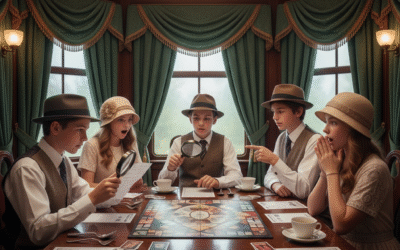Hosting a jungle expedition murder mystery from Megan’s Mysteries is an adventure in thrill, immersion, and unforgettable memories. This step‑by‑step guide will walk you through preparation, setup, execution, and debriefing—so every guest, from veteran sleuths to first‑time detectives, will be fully immersed in the wild world you’ve created.
1. Choose Your Adventure & Assemble Your Team
Start with the base kit—Megan’s “The Emerald Expedition” jungle expedition mystery. Its professional design, immersive storytelling, and well‑structured rounds make it a seamless experience. However, even if you don’t pick our mystery, this guide will help you execute a great event. Head over to the guide for hosting tips and FAQs to ensure you understand how to manage cast size, pacing, and game flow.
Select your guest list carefully—this theme thrives with 8 to 20 participants. Invitations should set the tone: include a brief character synopsis, suggested attire (think khaki, bandanas, adventure gear), and a teaser of what’s to come. Encourage them to show up in character and add their own flair.
2. Print, Prepare & Customize
Print your character bios, evidence packets, and map—the design is clean and themed, ready for parchment printing or standard paper. Want authenticity? Try sepia‑tone print settings, fold the map for added realism, and age the edges with coffee or tea.
If you’ve purchased the deluxe edition, pull out the faux artifacts—ancient gems, not-so-dangerous “weapons”, temple relics—and distribute them as physical clues as described in your Host Guide. These tactile items exponentially boost immersion and guest engagement.
3. Set the Scene
Turn your living room into a jungle encampment: leafy décor, faux vines, crash mat “campsite” zone, and lantern lighting. Create labeled areas: “Dig Site,” “Base Camp,” “Riverbank.” Use plant pots, brown fabric, and LED string lights to mimic dappled canopy lighting.
Play ambient jungle sounds at low volume; the audio layer will elevate tension without distracting from dialogue. Have evidence packets staged at each area, with corresponding props ready for revelations.
Want an easy and cute touch that everyone will appreciate? Head to Goodwill (or your local equivalent) and get a couple stuffed jungle creatures as an extra touch. Guests love it!
4. Host Prep & Running the Game
Study the host guide—it outlines round-by-round flow, timing cues, group discussion prompts, and key reveals. However, even if you don’t want to pre-study, our mysteries are written so you can wing it and still crush it.
Start with a brief orientation: cast introductions, ground rules (“Stay in character,” “No cell phones, except for pictures”), and an atmospheric opening to set the stakes. Then roll—move through two distinct rounds. Everyone will have tasks to accomplish and accusations and information to share.
Keep the pace tight. Each round could be as short as 20-25 minutes but often goes a bit longer – it depends on your cast and how “in character” they are. When someone uncovers a piece of evidence, allow them a moment to act—dramatically or quietly—depending on their character’s style.
5. Encourage Character Immersion
Provide prompts: share a secret when someone asks, barter evidence for information, sing a tribal chant at the dig site. Use the optional dialogue starters included in the script. Let your guests embellish—allow them to add a backstory detail or theatrical flair. The more they lean in, the richer the experience.
6. Include Physical Evidence & Props
Strategically deploy physical evidence: crushed temple coins in one packet, a ceremonial dagger sheath in another, maps with hidden X‑marks, and hidden bloodstain in the relic stand. Use sealed envelopes labeled “Only open during Round 2” to build anticipation.
Our deluxe kits come pre-packed with these and the host guide will tell you how to prep and deploy them.
Props tie the story together and reward curiosity. They spur reactions, arguments, confessions—exactly the kind of unscripted drama you want.
7. Reveal & Resolution
Allow time for final accusations—nominate suspects, vote, and let the accused present their defense. Follow the script’s reveal sequence: motive, opportunities, and the ultimate surprise twist.
8. Wrap‑Up & Clean‑Down
Congratulate the winners with small prizes: magnifying glasses, explorer hats, exotic or jungle themed keychains. Encourage guests to share their favorite moments and tag your event photos online.
Pack game materials into labeled folders (characters, evidence, props, host guide) for easy reuse. Even though the mystery can’t be replayed with the same group, your storage system makes it easy to host again or lend to another.
9. Post‑Game Follow‑Up
Email guests a thank-you note with a link to feedback or a photo gallery. Invite them to upcoming mysteries—mention maybe the upcoming The Missing Lamp or holiday theme in a soft tease.
10. Scale & Reuse the Success
Turn your jungle expedition into a repeatable template. After running it once, identify areas to improve: pace, prop placement, host-correlates. Refine your setup and then host at schools, youth groups, or for team‑building events.
Final Challenge
You’ve planned, prepped, and executed a wild expedition murder mystery. Now take it further: grab your phone, share the adventure—your props, your guests in character, your cliffhanger moments—and post them wherever your people spend time.
This isn’t just a game night—it’s a moment. Turn it into a memory: a teaser reel, a blog post, pin‑worthy Pinterest shots. Each success story spreads your story further.




0 Comments